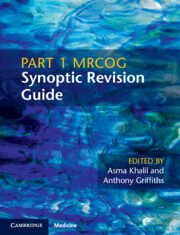Book contents
- Part 1 MRCOG Synoptic Revision Guide
- Part 1 MRCOG Synoptic Revision Guide
- Copyright page
- Contents
- Contributors
- Chapter 1 Physiology of Pregnancy and Labour
- Chapter 2 Fetal Physiology
- Chapter 3 Acid-Base Balance
- Chapter 4 Female Reproductive Physiology
- Chapter 5 Male Reproductive Physiology
- Chapter 6 The Pituitary, Adrenal, Thyroid and Pancreas
- Chapter 7 Congenital Infections
- Chapter 8 Data Interpretation in Obstetrics
- Chapter 9 Clinical Management in Obstetrics
- Chapter 10 Concise Anatomy of the Urinary, Intestinal and Reproductive Tracts within the Pelvic Cavity
- Chapter 11 Concise Anatomy of the Pelvic Floor and Perineum
- Chapter 12 Concise Anatomy of the Pelvic Girdle
- Chapter 13 Concise Anatomy of the Abdominal Walls
- Chapter 14 Early Embryonic Development
- Chapter 15 Development of the Gastrointestinal and Urogenital Tracts
- Chapter 16 Problems in Early Pregnancy
- Chapter 17 Human Immunodeficiency Virus and Other Sexually Transmitted Infections
- Chapter 18 Pharmacokinetics, Pharmacodynamics and Teratogenesis
- Chapter 19 Non-hormonal Therapy in Obstetrics and Gynaecology
- Chapter 20 Drugs in Gynaecology and Contraception
- Chapter 21 Surgical Site Surveillance
- Chapter 22 Data Interpretation in Gynaecology
- Chapter 23 Clinical Management in Gynaecology
- Chapter 24 Carbohydrate Metabolism
- Chapter 25 Fat Metabolism
- Chapter 26 Steroid Hormones and Prostaglandins
- Chapter 27 Calcium Homeostasis and Bone Health
- Chapter 28 Cell Structure and Function
- Chapter 29 Cellular Responses in Disease
- Chapter 30 Pathology of Non-neoplastic and Neoplastic Gynaecological Diseases
- Chapter 31 Implantation and Placental Structure and Function
- Chapter 32 Basic and Reproductive Immunology
- Chapter 33 Molecular Biology
- Chapter 34 Single-Gene and Chromosome Abnormalities
- Chapter 35 Genetic Screening and Diagnosis
- Chapter 36 Biophysics
- Chapter 37 Statistics
- Chapter 38 Clinical Trials, Audit and Meta-analysis
- Appendix: Answers to SBA Questions
- Index
- References
Chapter 15 - Development of the Gastrointestinal and Urogenital Tracts
Published online by Cambridge University Press: 27 July 2023
- Part 1 MRCOG Synoptic Revision Guide
- Part 1 MRCOG Synoptic Revision Guide
- Copyright page
- Contents
- Contributors
- Chapter 1 Physiology of Pregnancy and Labour
- Chapter 2 Fetal Physiology
- Chapter 3 Acid-Base Balance
- Chapter 4 Female Reproductive Physiology
- Chapter 5 Male Reproductive Physiology
- Chapter 6 The Pituitary, Adrenal, Thyroid and Pancreas
- Chapter 7 Congenital Infections
- Chapter 8 Data Interpretation in Obstetrics
- Chapter 9 Clinical Management in Obstetrics
- Chapter 10 Concise Anatomy of the Urinary, Intestinal and Reproductive Tracts within the Pelvic Cavity
- Chapter 11 Concise Anatomy of the Pelvic Floor and Perineum
- Chapter 12 Concise Anatomy of the Pelvic Girdle
- Chapter 13 Concise Anatomy of the Abdominal Walls
- Chapter 14 Early Embryonic Development
- Chapter 15 Development of the Gastrointestinal and Urogenital Tracts
- Chapter 16 Problems in Early Pregnancy
- Chapter 17 Human Immunodeficiency Virus and Other Sexually Transmitted Infections
- Chapter 18 Pharmacokinetics, Pharmacodynamics and Teratogenesis
- Chapter 19 Non-hormonal Therapy in Obstetrics and Gynaecology
- Chapter 20 Drugs in Gynaecology and Contraception
- Chapter 21 Surgical Site Surveillance
- Chapter 22 Data Interpretation in Gynaecology
- Chapter 23 Clinical Management in Gynaecology
- Chapter 24 Carbohydrate Metabolism
- Chapter 25 Fat Metabolism
- Chapter 26 Steroid Hormones and Prostaglandins
- Chapter 27 Calcium Homeostasis and Bone Health
- Chapter 28 Cell Structure and Function
- Chapter 29 Cellular Responses in Disease
- Chapter 30 Pathology of Non-neoplastic and Neoplastic Gynaecological Diseases
- Chapter 31 Implantation and Placental Structure and Function
- Chapter 32 Basic and Reproductive Immunology
- Chapter 33 Molecular Biology
- Chapter 34 Single-Gene and Chromosome Abnormalities
- Chapter 35 Genetic Screening and Diagnosis
- Chapter 36 Biophysics
- Chapter 37 Statistics
- Chapter 38 Clinical Trials, Audit and Meta-analysis
- Appendix: Answers to SBA Questions
- Index
- References
Summary
The primitive gut tube arises as a consequence of folding of the embryo, a process which is complete by the end of the fourth week after fertilisation. The primitive gut tube is formed as an endoderm lined tube with blind diverticula at the cranial and caudal extremities. These blind-ending diverticula are bounded from the exterior by the buccopharyngeal and cloacal membranes at the cranial and caudal ends, respectively. At its formation, and critical to development of the gastrointestinal (GI) tract, the primitive gut tube maintains continuity with the yolk sac from which it is formed via the vitelline duct at the umbilicus.
- Type
- Chapter
- Information
- Part 1 MRCOG Synoptic Revision Guide , pp. 114 - 119Publisher: Cambridge University PressPrint publication year: 2023

